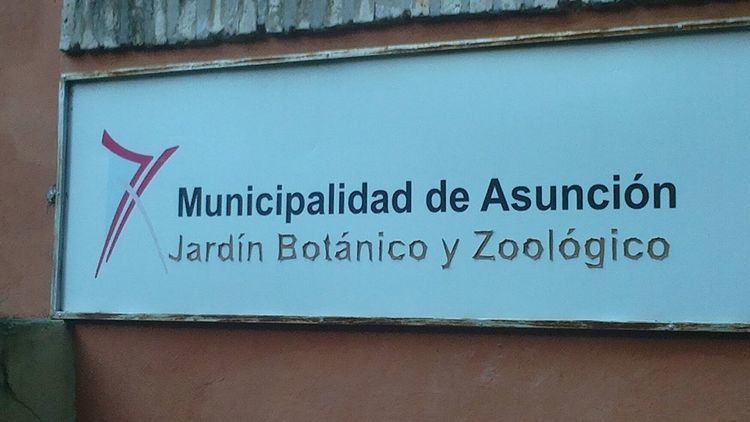Designer Anna Gertz Phone +595 21 281 390 Number of species 64 | Created 1914 Opened 1919 Number of animals 337 | |
 | ||
Motto Natura miranda in maximum minimis investigacioni rerum naturalium Paraguarie consecrata Area 110 hectares (270 acres) Address Av Primer Presidente, entre Ruta y Av. artigas, Transchaco, Asunción, Paraguay Founder Karl August Gustav Fiebrig Similar Museo del Barro, Palacio de los López, Hotel Guaraní Esplendor, Estacion Central del Ferrocarril, National Pantheon of the Her | ||
Cheap hotel asuncion
The Botanical Garden and Zoo of Asunción (Jardín Botánico y Zoológico de Asunción) is a botanical garden and zoo located in Asunción, capital of the Republic of Paraguay.
Contents
- Cheap hotel asuncion
- History
- Facilities and collections
- Botanical Garden and Nursery
- Zoo
- Mammals
- Birds
- Reptiles
- References
The Botanical Garden and Zoo is one of the principal open spaces of the city of Asunción, set in natural forest covering 110 hectares (270 acres) to the north of the city. The zoo is home to nearly seventy species of wildlife including birds, mammals and reptiles, mostly representing the fauna of South America. The botanical garden is home to native species, exhibiting in particular the variety and beauty of its lush trees.
History
This sprawling property was the former country house and estate of Carlos Antonio Lopez, president of Paraguay between 1842 and 1862. Lopez ordered the construction of "Casa Lopez" as his home in the 1840s. Besides its historical value, the main building is very representative of the era in which it was built, in terms of technology, architecture and decoration, and is registered in the "Catalogue of Buildings and Sites of Urban Planning, architectural , Historical and Artistic Heritage of the city of Asunción",and specially protected by Law 946/82 "Protection of Cultural Property".
In 1896, Lopez's descendants sold the estate to the Agricultural Bank, by then in state ownership.
The garden was created as such in 1914 by German scientists Karl Freibig and his wife, Anna Gertz. Fiebrig was professor of botany and zoology at the University of Asunción, having settled in Paraguay in 1910 following plant and insect collecting trips to Paraguay for European museums between 1904 and 1909. Fiebrig founded a school of Agriculture in 1916. Fiebrig also founded a "Cotton Institute" which helped fund the garden complex. The zoo was subsequently established by the same scientists, with a very advanced approach for the time, housing the animals in a setting as close as possible to their natural habitat. Gertz is credited with much of the landscape design of the gardens, though some projects were truncated following her death in May 1920. She was buried in the gardens.
Fiebrig continued as director of the garden and zoo, and remarried in 1925. In addition to his professorship, in 1934, was also made director of the Paraguayan Department of Agriculture. In 1936, in the aftermath of the Chaco War, a wave of xenophobic sentiment forced Fiebrig to leave Paraguay with his second wife and family. Responsibility for the estate passed from the state to its present owner, the Municipality of Asunción.
Historically, the estate covered more than 600 hectares (1,500 acres), and had over 1 km frontage along the bank of the Paraguay River, a port, a railway station and 60 km of road network. In the last 50 years, there have been several incursions, such as the riverside Empresa de Servicios Sanitarios del Paraguay (ESSAP) Viñas Cué water treatment plant, the Copaco transmission station (built at the time of dictator Stroessner), the Asunción Golf Club, laid out by Fiebrig, and several other divisions due to illegal occupations.
Since 2013 the garden and zoo's director has been Maris Llorens.
Facilities and collections
The facilities include:
Botanical Garden and Nursery
The nursery is located behind the Upper House and contains over 500 species specialising in medicinal plants. It is open to the public and works in cooperation with the Botanic Garden and Conservatory of the City of Geneva, Switzerland.
Established for over 10 years, it has undertaken investigations into the cultivation, distribution and introduction of plants, specifically native, but also medicinal plants introduced by Paraguayan settlers.
The work of the Conservatory is to preserve the culture of the knowledge of medicinal plants in Paraguay. "The Paraguayan people consume herbs and know the use of at least 50 species. The work of the nursery is to investigate cultivation, harvesting and propagation and to use that knowledge for education".
Among its collections are:
On 4 May 2006 the gardens launched the exhibition Ethnobotany 2006 "Our plants, our people" ("Spanish"), under the Paraguayan Ethnobotany Project (EPY) (which lasted for about ten years), with the support of the Conservatory and Botanical Garden of the City of Geneva and under the auspices of the organization Tesãi Reka Paraguay (TRP).
The project helped improve the botanical garden and created a large Paraguayan medicinal plant collection and the Center for Conservation and Environmental Education (CCEAM) located in the Botanical Garden, which develops numerous educational activities.
Zoo
The zoo is located on the same site. The zoo's collections focus on the fauna of Paraguay but include animals from elsewhere.
Mammals
Birds
Birds include:
